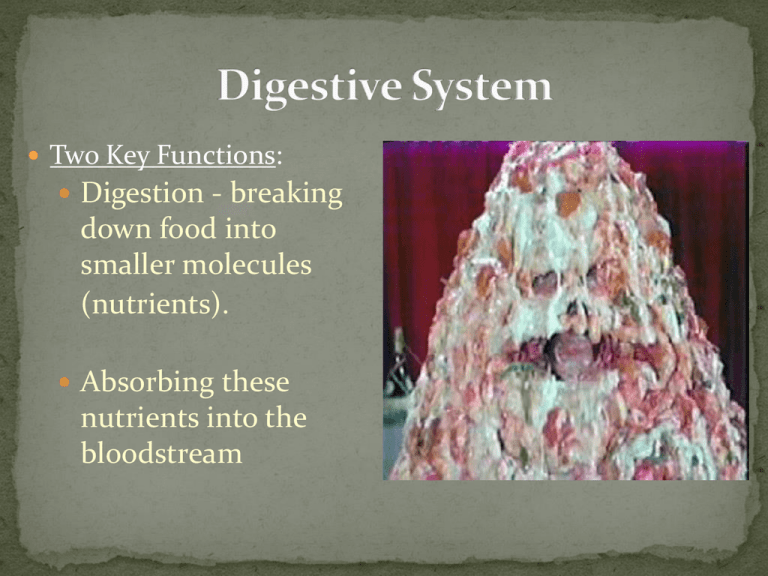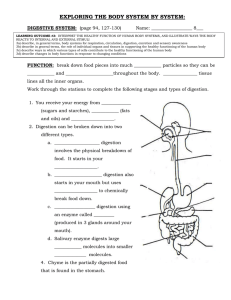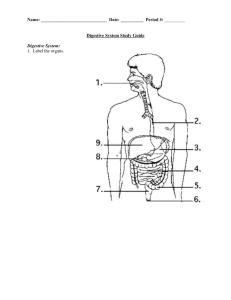Digestive System
advertisement

Two Key Functions: Digestion - breaking down food into smaller molecules (nutrients). Absorbing these nutrients into the bloodstream MECHANICAL CHEMICAL Parts Mouth Pharynx Esophagus Stomach small intestine Liver Gallbladder Pancreas large intestine Rectum Mechanical Digestion Tongue and teeth work together to break down food mechanically Chemical Digestion Amylase - enzyme in saliva that breaks the carbohydrates Starch Simple Sugars No digestion Food is directed from mouth to stomach using peristalsis Epiglottis – flap of cartilage Ensures food travels to esophagus and not wind pipe (larynx) Large muscular sac that continues digestion Acidic pH – 2-3 on the pH scale Cardiac sphincter – circular muscle that keeps food in stomach Mechanical Digestion Peristalsis Chemical Digestion – protein digestion begins here HCL and Pepsin - pepsin (enzyme) and hydrochloric acid begins protein digestion. HCL changes inactive enzyme, pepsinogen active pepsin Chyme - mixture of stomach fluids and food produced in the stomach by contracting stomach muscles Digestion is completed and nutrients are absorbed here. Small in diameter, not in length (> 6m) Chemical Digestion completed here. Digestion Intestinal Enzymes Pancreatic amylases – starch Peptidases (trypsin, chymotrypsin) – proteins amino acids Nucleases – nucleic acids nucleotides Lipases – break down fat Nutrient Absorption – Villi (villus-singular) – millions of fingerlike projections (latter portion of small intestine) Increase surface area Liver - large organ just above the stomach that produces bile, a fluid loaded with lipids and salts Produces bile that digests fat Sends bile to gallbladder for storage Gallbladder Stores bile Cholesterol Deposits (gallstones) Pancreas Secretes peptidases – protein digestive enzymes large intestine No digestion 2 major functions Egestion – removal of undigested waste Rectum – stores feces for release Anus – Releases feces Reabsorption Water is absorbed Belching / Burping swallowed air, eat fast, improperly fitted dentures, & chewing gum Intestinal gas foods rich in fiber, starches, & sugar beans, dairy, some vegetables bacteria in the GI fat substitutes GERD - gastroesophageal reflux disease painful, persistent heartburn (acid in esophagus) cause: hiatal hernia, cigarette smoking, alcohol, overweight, pregnancy, chocolate, citrus, spicy or fried foods, large high-fat meal 14 Peptic ulcers areas of GI eroded by HCL & pepsin Helicobacter pylori – bacteria contributes to production of gastric & duodenal ulcers Food allergy hypersensitivity reaction of immune system Food intolerance GI gas, pain, diarrhea, or constipation 16 Celiac disease (celiac sprue) genetic disorder inability to absorb gluten - protein in wheat, rye, & barley Immune cells damage the small intestine leads to poor nutrient absorption requires a diet lacking wheat, rye, & barley early diagnosis avoids delayed growth & malnutrition Crohn’s disease inflammatory bowel can affect any area of the GI tract possible immune system reaction to a virus or bacteria diarrhea, abdominal pain, rectal bleeding weight loss, fever, anemia children can experience delayed growth 17 Ulcerative colitis chronic disease of the colon inflammation & ulceration of inner most lining possible immune response to a virus or bacteria symptoms are similar to Crohn’s disease not caused by food patients may avoid foods that cause discomfort Diarrhea frequent passage of loose, watery stools Infection, stress, food intolerances reactions to medications, or bowel disorders can lead to severe dehydration more dangerous for children & the elderly 18 Constipation infrequent hard, small, difficult to pass stools prevention includes fiber-rich foods & regular exercise Irritable bowel syndrome (IBS) interferes with normal colon function abdominal cramps & bloating diarrhea or constipation stress, caffeine, large meals, chocolate, alcohol, dairy, wheat more common in women treatment includes stress management, high fiber diet, fluids, avoiding offending foods 19








